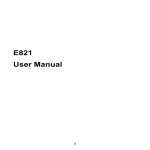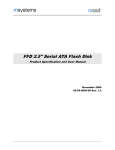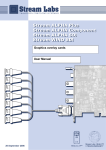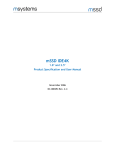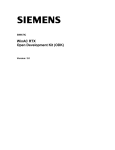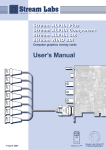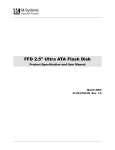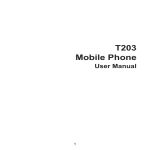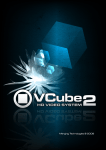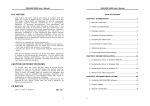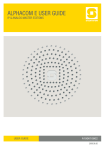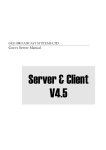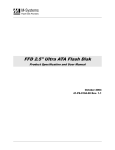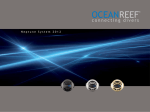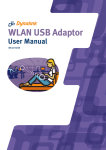Download User`s Manual
Transcript
STREAM Labs USER’S MANUAL What is the STREAM Titling Station? The Stream titling station is a computer system for mixing video signal and computer information. The system is developed as an open platform and allows to use a variety of computer software. The hardware configuration consists of an IBM-compatible PC with titles and graphics superposition and output cards. The generator native software runs under Windows 98/NT/2000/ХР operating systems. The open architecture allows to form character generation sets specifically according to their supposed application. The standard package includes all necessary interfaces for the use of character generators as a comprehensive broadcasting station in programs edition and live broadcasts. Stream character generators are available as complete devices or sets of individual cards and software packages. All products are under a five-year warranty, and the software updates are free of charge. We currently produce Stream Alpha titling cards of three types, according to different types of signals they work with: • Stream Alpha plus – to work with composite, S-Video, and RGB or YUV component signals. • Stream Alpha Component – to work with YUV (RGB) component signals. • Stream Alpha SDI – to work with the SDI serial digital component signal. Stream Alpha cards and the Alpha Pro 2.0 software can be use in a wide range of applications: • TV programs titling during editing and live broadcasting; • TV program logotypes production; • automated screening of current time, temperature, atmospheric pressure, and other similar information (additional equipment required); • audience telephone polls during live broadcasts (additional equipment required); • informational and graphical design of sports broadcasts; • generation of various digital and analog clocks and timers; • pre-scheduled broadcasting of informational and advertisement blocks; • animation and video clips playback (in 4:4:4, 4:2:2, DV type 2, and AVI formats); • subtitling. 1 USER’S MANUAL STREAM Labs System Components in Brief 1. The Stream Alpha plus Real-Time Titles and Graphics Superposition and Output Device The Stream Alpha plus card works with composite, S-Video, and RGB (YUV) component signals. The card has a digital-only path of image shaping which provides a betterquality shaped signal and a better tie-in to the input signal. The card uses an alpha channel with a palette to superimpose graphics on the passingthrough signal. The use of the alpha channel allows to assign an individual level of transparency for each image point. The palette allows to change this degree of transparency during the subsequent work (e.g., for the Fade-In/Out effects) without re-drawing the alpha channel. Audio signal and other control information pass through the card unchanged. The card is equipped with a stand-alone synchro generator, which switches on automatically in absence of a synchronizing signal. On the computer power-down or when the BYPASS mode is on, input and output get locked through a relay, and the 75 Ohm load of the card gets switched off. The card can also be used for a computer graphics superposition over a TV image either internally or with an external mixer. To this end, the card is equipped with an alpha channel output and the option of switching the multiplication of the computer-produced image and the alpha channel signal off. In addition to the traditional analog mixing, the latest version of the Stream Alpha plus card features a digital mixing mode, which comprises the input signal decoding. Mode the card can be switched from the passing-through signal mode to decoding. The decoding (together with the ensuing encoding) produces a nearly 10 µs delay but allows to choose between various standards of input and output signals, as well as to treat input signals of lower quality, without deteriorating the quality of the output. The component RGB (optionally, YUV) and key (alpha channel) signal outputs allow to use the card with a mixer equipped with a component input and a Down Stream Key (DSK) input. Technical Specification: Size 176 х 107 mm Bus PCI 32bit Palette 16 million colors Alpha channel 256 transparency levels Alpha channel delay adjustment Yes, 0-255 Alpha channel sub-carrier phase control Yes, 0-255 Graphics/passing-through signal respective position adjustment Yes, 0-1727 Inputs Composite PAL, SECAM, NTSC S-Video PAL, SECAM, NTSC Outputs Composite PAL, SECAM, NTSC S-Video PAL, SECAM, NTSC RGB+DSK (YUV+DSK) Bandwidth > 10 MHz Differential non-linearity < 0.2% 2 USER’S MANUAL STREAM Labs 2. The Stream Alpha Component Real-Time Titles and Graphics Superposition and Output Device The Stream Alpha Component titling card works with a component YUV signal. A novel 10-bit digit-to-analog converter with a 4x over-sampling is used for the graphics generation. The card works on a 32-bit PCI bus and has a 64-bit memory bus. The card own memory bank amounts to 16 Mb. The card has a digital-only graphics generation path and works in both analog and digital mixing modes. In the digital mode, the input signal gets digitized, mixed with the graphic and transported to the output. The signal delay is about 10 µs. The digital mixing mode can use component YUV or RGB, as well as composite or S-Video input signals. In the latter case the signal is decoded with the innovative Philips decoder. This decoder uses an adaptive color combine filter to separate brightness and color signals. In the analog mixing mode, the card superimposes the graphics over the passingthrough video signal in component YUV or RGB (optionally) formats, using the alpha channel with a palette. The alpha channel allows to assign an individual level of transparency for each image point. The palette allows to change this degree of transparency during the subsequent work (e.g., for the Fade-In/Out effects) without re-drawing the alpha channel. The card is equipped with a stand-alone synchro generator, which switches on automatically in absence of a synchronizing signal. On the computer power-down, or when the BYPASS mode is on, input and output get locked through a relay, and the 75 Ohm load of the card gets switched off. The card is also equipped with a dedicated synchronization input and a composite (PAL) output. The superposition of the computer graphics over the TV image can be done either internally or with an external mixer using a card-generated key signal transported via the dedicated alpha channel (Key) output. Technical Specification Size 177 х 106 mm Bus PCI 32bit Palette 16 million colors Alpha channel 256 transparency levels Alpha channel delay adjustment Yes, 0-255 TV standard 625/525 lines Y, U, V (R,G,B) inputs 0,7 V / 75 Ohm Synchro signal 0,3 V / 75 Ohm Y, U, V (R,G,B) outputs 0,7 V / 75 Ohm Preview output 1,0 V / 75 Ohm Alpha channel output 0,7 V / 75 Ohm 3. The Stream Alpha SDI Real-Time Titles and Graphics Superposition and Output Device The new Stream Alpha SDI card is a multi-functional video card, which can replace several studio devices at once. Apart from its main functionality of superimposing the graphics over the passing-through digital SDI signal or its supplying to an external mixer, the card can also be used as a transcoder between analog and digital SDI video signal formats, or as a 3 STREAM Labs USER’S MANUAL grabber of individual frames or video clips. The Stream Alpha SDI card works with 8- and 10-bit serial component SDI input signal and outputs a 10-bit signal in full compliance with the CCIR656 and SMPTE259m recommendations. At the signal passage through the card all control information is preserved, and the audio packages can be preserved or replaced, as required. The input signal is checked for errors with an EDH control sum calculation. The output EDH packages are always formed anew in compliance with the SMPTE165 recommendation. The card is externally synchronized with the input video signal. When the output signal only consists of computer graphics, the Black Burst synchronization signal can fed to the main input or the auxiliary analog input. If no external synchronization is available, the internal generator can be used. The device can be used with an external mixer equipped with a Down Stream Key (DSK) input. To this end, dedicated analog and digital key (alpha channel) signal outputs are provided. The card setup software tool offers a wide range of positive and negative key signal delay settings with respect to the output graphics. On the computer power-down, or when the BYPASS mode is on, input and output get locked through a relay, and the 75 Ohm load of the card gets switched off. The computer startup and the card initialization do not distort the passing-through signal at the output. The new version of the card allows to reproduce the input video signal, and the result of its mixing with the computer graphics, at the computer monitor in real time. Computer Graphics Buffer Video card memory buffer for computer graphics output is 720 x 576 points for 50 Hz video systems, and 720 x 240 for 60 Hz video systems. Each point has a 32-bit representation, 24 bits of which represent the point color (16 million hues), and the remaining 8 bits are used to represent one of the 256 grades of transparency (alpha channel). Although a computer graphics point color component is represented by 24 bits (8 x 8 x 8), a 30 bit (10 x 10 x 10) representation is used for mixing, i.e. if the input signal is a 10-bit, it will remain the same at the output after the mixing. Graphics buffer memory and PCI bus bandwidth of the modern computers makes it possible to update the buffer contents in real time, without frame dropping, while transmitting uncompressed video (32 bit/pixel) together with the sound. Sound can be included in the SDI format output signal and be played through the computer sound card simultaneously. All this allows to use the video card for broadcasting not only soundless titles and logos, but also fullscreen clips with sound. This does not require a separate video station with an offline editing card, all output is performed through a single card from a single computer. It simplifies the overall switching topology and ensures simple and reliable broadcasting automation. Chroma key is another way to define mixing proportions, when an individual proportion of mixing with the computer graphics is set up for each specific color group of a video signal. Moreover, if the earlier-used 12 bit (4 x 4 x 4) color space could only allow a rough determination of the “cut-out” areas, the present use of the associative memory makes it possible to expand its dimension to 24 bit (8 x 8 x 8). Together with semi-transparent mixing, this ensures a very high precision at the video signal and computer graphics borders which do not “boil” any more. If the passing signal has a high level of noise, a mask on the lower bits in its digital representation can be used. Signal Format Conversion The Stream Alpha SDI video card has, apart from the serial digital input, analog YUV/RGB, S-Video, and Composite inputs. It can form analog YUV/RGB, S-Video or Composite 4 STREAM Labs USER’S MANUAL output signals simultaneously with the SDI signal, regardless of the input used (only one auxiliary composite output was available before). Input signals may be in PAL, SECAM or NTSC formats, and the output ones – in PAL or NTSC only. Frame rate cannot be changed, i.e. an NTSC signal can only be obtained and converted from NTSC. The input decoder distinctive feature is the 9-bit signal processing and the separation of brightness and color components in composite PAL, SECAM and NTSC, based on a band-split adaptive «color combine filter» (rather than a rejector filter used before). It does not narrow the bandwidth of the brightness channel. The 9-bit signal processing allows to preserve all 256 brightness levels in the course of digitalization, rather than the 160-170, which could only be maintained in the case of the 8-bit signal processing. A 10-bit digital-to-analog converter with 4x over-sampling is used for the generation of the output analog signals. This enables a complete signal filtering from the high-frequency noise without additionally reducing the bandwidth of the output signal brightness channel. Single-Frame and Video Clip Capture Any of the Stream Alpha SDI card input signals can be captured: Composite, S-Video, YUV/RGB, or SDI. The latter is especially important since the input signal component 10-bit depth is preserved. The video card allows to capture video clips to a hard disk or computer memory in real time without any compression or loss of frames. Such SDI/YUV/RGB grabbers are very rare and can prove very handy in video production offline editing, slow video replay or storage of images. Two such cards used together can make it possible to create a video delay line for a few seconds or even minutes. Additional Video Image Processing and the Open Architecture The card is supplied with a powerful general-purpose Phillips Trimedia processor and the memory for the program loading. It means that, without physically changing the card, new opportunities can be obtained through an upload of micro programs of “virtual” logical elements operation. Besides, it allows not only to change the card logical structure, but also to alter the very algorithms of video processing. It allows, for example: • to add compressed image processing options; • to upload the input signal progress monitoring program, which is actually used in security and supervision programs developed by the STREAM Labs for security systems; • to monitor the domains of connectivity in Chroma Key formation; • to apply textures in real time using the input image, etc. 4. The Alpha Pro 2.0 Software in Brief What is Alpha Pro? Alpha Pro 2.0 is a program running under the Windows 98/2000/XP operating systems, which allows to create scenarios (title sequences to be output with various effects) and play them back through a device for the computer graphics superposition over a TV/video signal. From the user’s point of view it resembles a multi-window text processor, in which several scenarios can be edited and kept ready for the output simultaneously. Besides, the same scenario can be opened in several separate windows, which simplifies on-the-fly changing of the various parts of the text. 5 STREAM Labs USER’S MANUAL A scenario is paged, number of pages being unlimited. An individual video effect can be assigned to each page determining its appearance, motion and fading out from the video screen. The following effect types are supported: vertical text upward movement, Drum, Roll, Creeping Line (horizontal movement of an “infinite” page from right to left), Crawl, static page Cross Fade with a pause for display, Wipe (including user-defined, with the adjustable “transition softness”), animation playback over “static” pages, effects with operating areas restricted to a certain part of the screen, animation symbols in Roll or Crawl pages. Userdefined parameters for video effects include the application area, speed and delay duration. The Alpha Pro 2.0 software distribution CD contains a detailed description of the program use procedures: alpman.pdf (1.59 Mb) and alpmana.pdf (0.23 Mb). The Alpha Pro 2.0 Extended Version Enables the management of external application objects, including user-developed programs. That comprises programs written in Microsoft Office VBA script language, including Word, Excel and Access scenarios, programs in Visual Basic, Web pages containing scenarios in VBScript, and programs written in Delphi and Visual C++. That allows the user to play back the required pages at the required moment and to modify the program in the course of playback (for real-time presentation of any computer input information). Connecting the computers with video cards into a network enables a centralized output control from a single program. Broadcasting design is set up in the form of templates that may be prepared beforehand and/or edited “on air”. Real-time data are merged into a template immediately at the playback moment. A function is provided for automatic screen update synchronously with the input data updates. A system of any capacity may be constructed out of standard equipment (IBM PC’s, video cards) and reconfigured if necessary. The user can edit templates at will and, if necessary, write dedicated Visual Basic, VBScript or VBA programs for specific tasks. 6 STREAM Labs USER’S MANUAL The Internet Explorer in-built VBscript language can be used to concentrate all program controls within one or several HTML pages comprising text input fields and operation buttons. Consider a set of the “Name” text input field and the “Show” and “Hide” buttons. Through writing an appropriate scenario and preparing the Alpha Pro page templates it is possible to set rigidly the design style (background, name display font) and the effects for its appearance and fading out. It allows to obtain a “control panel” without superfluous distracting control elements. Live Broadcasts Having prepared page templates based on the broadcast design style, and written the management scenario in Visual Basic, it is possible to broadcast appropriate pages at the right moment making software changes directly at the moment of broadcasting (for real-time presentation of any computer input information). It solves the design problems of sports events translation, game shows, etc. The same approach enables “telephone polls” broadcasting by installing the required amount of modems into the computer or using a dedicated card for this purpose. With a high-precision SMPTE/EBU format time-code source it is possible to program a schedule of the page broadcasting time specifying the calendar functions and precision up to one frame, which enables an automated airing of simple commercial inserts (creeping lines, logos, animation logos). This function has been used by Russia’s RTR TV channel for the LG animation logo output. User’s interface (an HTML page) can be tailored by the user so as to exclude all incidents in the course of broadcasting, only keeping the strictly necessary functions (to choose the title text from the list, to broadcast the title, to hide the title). 5. The TELE System The TELE system is a video server software used for an automatic pre-scheduled playback of logos, titles, animations and video clips. It is recommended for automation of a TV company broadcasting, and for integration of regional commercials and broadcasts into a television network broadcasting timetable. This program is a logical sequel of the wide-known Alpha Pro 2.0 TV character generation software. It allows to convert a title generation station into a regular video server keeping its title creating capabilities intact. Video File Formats Support • DV type (2 720x576), 4:2:0, compression 1:5, audio 48 KHz stereo (supported by the Pinnacle Dv500 and Matrox Rt2500 video cards) • MJPEG* (720x576), 4:2:2, compression 1:3, audio 48 KHz stereo, miroVideo DC30/DC50, and Matrox DigiSuite cards output formats. • 4:2:2, a compression-free format, converted from the AVI format by the Conv422 converter included in the TELE package, or a video capture program (if the system includes a grabber). It features the highest quality of D1 for video (720 x 576 x 4:2:2) and a 48 KHz stereo format for the sound. Besides, the 422 format does not have the 4 Gb AVI file size 7 STREAM Labs USER’S MANUAL restriction. Estimated storage capacity is 60 minutes for a disk set of 2x80 Gb. • The 444-type animation files do not contain sound, they are formed through a TGA 32-bit file train conversion. They can be used to produce animation logos and presentations. There is a flow rate restriction which prevents the updating of more than one half of the screen area per frame. Resolution – 720x576x32 bits. • Systems based on the P4 2,2 GHz and higher enable playback of any format AVI files provided the codec of this format is installed in the system (Indeo, DIV-X, MPEG4, etc.) The program allows to combine source video files of different formats into video blocks with the help of the simplest editing tools (clip trimming, line editing), as well as to correct some visual parameters of the video clips (brightness, contrast, saturation, etc.). Moreover, the video files of a block can be played back by fragments rather than as a whole, i.e. a block can comprise fragments of different video clip arranged at will. The TELE system also enables a superposition of logotypes (including dynamic logos) and pointer clocks over the video files played back. Another block variety is SC/Audio blocks. Video and audio track content is filled separately and independently. SC/Audio video track is a train of files containing SC-type Alpha Pro 2.0 titles. Their total duration determines the length of the SC/Audio block. So, if you use offline systems based on Miro DC30+/DC50 video cards, or systems based on the DV format, and need a solution for broadcasting files created in these systems; If you are going to automate the pre-scheduled commercial inserts broadcasting and need a convenient solution for building up advertising blocks and play-lists with a possibility of editing them in the course of playback, or if you need to insert animation logos moving over the screen; If you find it more convenient to transfer clips to the broadcasting computer over the network instead of writing them on your VCR and broadcasting manually through a control console; If you would like to be able to insert commercials and video clips right into the passing video signal, without mixer – Then this is a program for you! 8 STREAM Labs USER’S MANUAL Delivery Package Contents 1. Hardware – 1 PCI bus Stream Alpha card. 2. TV character generation software – Alpha Pro 2.0 distribution CD. 3. This STREAM Titling System Hardware Setup Guide and User’s Manual. 4. The Alpha Pro 2.0 software User’s Manual. The program’s functions are described more in detail in the PDF format files included in the distribution CD. 5. A HASP hardware dongle to be inserted in the computer LPT serial port – required for the Alpha Pro 2.0 operation. For specific versions of the titling card, the delivery package may also include: 6. For the Stream Alpha plus card, a 15-pin, 4xBNC YUV cable – to connect to an external Component mixer via the YСrСb + Alpha Key or the RGB + Alpha Key DSK inputs. 7. For the Stream Alpha Component card, a 37-pin, 8xBNC cable to connect the synchronization outputs and the, and the alpha channel outputs and the Y, Cr, Cb outputs. System Requirements 1. Intel-based IBM PC: Celeron (Pentium III based), Pentium III or Pentium IV. Minimal configuration – an 933 MHz Intel Pentium III processor. Additional cooling inside the case is recommended. For Stream Alpha SDI minimal configuration is PIV 2,0 GHz. 2. CD-ROM drive. 3. One vacant PCI slot. 4. At least 128 Mb RAM. 5. At least 200 Mb of unused hard disk space. 6. An AGP bus VGA video adapter recommended. Motherboard-integrated video adapters can cause problems. 7. Windows 98/2000/XP operating system. Any Windows graphical mode with the High Color (16 bit) 800x600 pixel resolution or higher (1024x768 pixel recommended). 8. A quality video signal source and a video monitor are required. Recommended motherboard models for the Pentium IV platform: ASUS P4B266-C, ASUS P4B266-SE, ASUS P4T-E, ASUS P4T533-C Workplace Setup The computer and video equipment power must be supplied from the same power mains. The computer must be grounded. If the power mains provide a separate grounded cable, use it; otherwise utilize the ground of the power switchboard (this operation must be performed by a qualified professional). The grounding quality determines the safety of your equipment, as well as the quality of the image. Connecting the computer and video equipment cases with a common cable is also recommended for the noise reduction. 9 USER’S MANUAL STREAM Labs ! WARNING! Never switch the connecting wires while the computer or video equipment is on. It can result in a wreck of the video system, computer or video equipment. Before any switching, all the equipment must be disconnected from the power mains. Connector Assignment of the Stream Alpha titling cards Familiarize yourself with the arrangement and the assignment of the connectors of the cards before the setup and connection of the Stream Alpha cards. 1. Connectors Assignment of the Stream Alpha plus Card • S-Video out: Output connector for the S-Video (Y/C) PAL, SECAM, and NTSC format video signals. • Composite out: RCA connector for the PAL, SECAM, and NTSC format video signals output. • S-Video in: Input connector for the S-Video (Y/C) PAL, SECAM, and NTSC format video signals. • Composite in: RCA connector for the PAL, SECAM, and NTSC format video signals input. • YUV+Key/RGB+Key: 15-pin connector for a special four-BNC connector block: the key signal output (white) and the Y, Cr, Cb or G, R, B signal outputs (respectively, green, red, and blue). The YUV+Key operation mode is only supported by the Alpha Pro 2.0 extended version software. The optional connector block is not included in the standard delivery package, but can be supplied separately. The 15-pin connector configuration: 10 USER’S MANUAL STREAM Labs 1 2 3 4 5 R/Y G/U B/V - - 6 7 8 9 10 ground ground ground - ground 11 12 13 14 15 Key - - - - 2. Connector Assignment for the Stream Alpha Component card • RCA connector: composite signal output. • 37-pin connector for the “tail” consisting of two 4-wire bunches. One of them contains the synchronization input (black) and Y, Cr, and Cb outputs (green, red, and blue, respectively). The other bunch includes the alpha channel output (white) and the Y, Cr, and Cb inputs (green, red, and blue, respectively). Any connection to the input of the new version Stream Alpha Component card must provide a synchronization (black connector) and Y (green connector) signals. Preview Out The 37-pin connector layout: 1 2 3 4 5 6 7 8 9 10 11 12 13 14 15 16 17 18 19 - - B - V - U - Y - - - W - V - U - Y 20 21 22 23 24 25 26 27 28 29 30 31 32 33 34 35 36 37 - G - G - G - G - - - G - G - G - G B – synchronization input; W – alpha channel output; G – ground. 11 USER’S MANUAL STREAM Labs 3. Connector Assignment for the Stream Alpha SDI card The card is equipped with three BNC connectors, one RCA connector, and a 15-pin connector for a special seven-BNC connector block: the key signal output (white) and the Y, Cr, Cb or G, R, B signal outputs (green, red, and blue, respectively). The card has an SDI output, a PAL Composite input/output, a YUV(RGB) input/output, and the DSK digital alpha channel input and output for a mixer connection. When the card is connected to a mixer, the synchronization channel can be taken from the analog or the SDI input. The 15-pin connector layout: 1 2 3 4 5 Cr(R) out Y (G) out Cb (B) out - - 6 7 8 9 10 ground ground ground - ground 11 12 13 14 15 Key in Y (G) in Cb (B) in Cr (R) in - The Alpha Pro 2.0 Software Setup 1. Install the provided HASP4 hardware dongle in the LPT1 serial port of your computer. The software individual number XXX is marked on the dongle. 2. Insert the Alpha Pro 2.0 distribution CD into the CD drive and run: CD-Rom\Setup\KeyXXX\Setup\Setup.exe Further software setup is performed automatically; the user is only to specify the folder for the software installation. Changing the suggested path of the installation folder is not recommended. 3. Turn the computer off. 12 USER’S MANUAL STREAM Labs Setup and Connection of the Stream Alpha Titling Cards 1. Open the computer case cover and install the titling card into a vacant PCI slot. Be careful. Hold the card by its edges trying not to touch voltage stabilizers and other components of the card in order not to damage them. • If a PCI VGA adapter is present in your computer, install it in the first PCI slot. The slot numbers are usually marked either on the motherboard itself or in the user’s manual provided. It is recommended to install the Stream Alpha card in a minor slot as compared to the VGA adapter. • If your computer uses an AGP VGA adapter, the Stream Alpha card can be installed in any PCI slot. It is not recommended to install the Stream Alpha card in the slot next to the AGP, as the present-day video adapters tend to heat significantly. Stream Alpha card installation requires the following parameter to be set at the motherboard BIOS setup: PNP/PCI CONFIGURATE > Primary Graphics Adapter: AGP 2. Close the computer 3. Connect the video signal sources and receivers. • For the Stream Alpha plus card. If you use a video recorder as a video signal source, note that only professional video recorders featuring the Time Base Corrector mode can be used. The signal quality cannot be guaranteed if you use a household video system. If both S-Video and Composite signals are available in the path, it is recommended to use the S-Video signals. This usually results in a much higher quality image. The card new version allows to use any wire connection layout in the coding/decoding mode. This also gives you a freedom of the standard choice for the card input and output signals. If the card is connected in PAL Composite–PAL Composite or PAL S-Video–PAL S-Video mode without any coding and subsequent decoding, the signal passes through the card transfer relays unchanged. If the signal does not pass through the card, it may mean that the card jumper is in a wrong position or absent. When connecting the card via the 15-pin VGA connector in the RGB+DSK or YUV+DSK mode, note that the card default output signal is always RGB. The YUV+DSK mode is only available with the software extended version. Analog Mixing Input Digital Mixing Output Input Output PAL Composite PAL Composite Composite Composite/ S-Video PAL S-Video PAL S-Video S-Video S-Video/ Composite 13 USER’S MANUAL STREAM Labs Synchronization Composite/ S-Video RGB+Key YUV+Key Composite RGB+Key YUV+Key S-Video RGB+Key YUV+Key Following combinations of standards are possible at the Stream Alpha plus card inputs and outputs. Note that the card output SECAM signal does not comply with the Russian GOST standard. PAL SECAM NTSC PAL Ok Ok - SECAM Ok Ok - - - Ok NTSC • For the Stream Alpha Component card. When using the Stream Alpha Component card in a pass-through mode, connect the synchronization signal (black) and YUV inputs (green, red, and blue). The output then yields a Video + Graphics superposition in YUV (green, red, and blue) and PAL Composite format. When working with an external mixer, connect the synchronization (black) and Y (green) signals to the card inputs. The output then only yields a Graphics signal in YUV (green, red, and blue) + DSK (Down Stream Key) and PAL Composite format. • For the Stream Alpha SDI card. In the pass-through mode, only SDI input and output should be connected. The card output then yields a Video + Graphics PAL Composite signal. When working with an external mixer, connect a synchronization signal to the SDI or Composite input. The choice of the input is not important. The card output then yields Graphics SDI и PAL Composite signals, and the DSK alpha channel output to be connected to the mixer. Card Driver Installation and Alpha Pro 2.0 Software Setup ! Warning! It is recommended to install the Alpha Pro 2.0 software before the physical installation of the cards in your computer. It will facilitate the driver setup procedure. Stream Alpha plus and Stream Alpha Component Cards Driver Installation and Alpha Pro 2.0 Software Setup Under Windows 2000/XP The Alpha Pro software can work with the Stream Alpha plus card under Windows 2000 in the ACPI mode. In this mode, all devices are ascribed the same interruption. However, it is recommended to set up the Windows 2000 system in the Standard mode, when each device gets a specific interruption. To do so, open the Windows 2000 Device Manager and run 14 STREAM Labs USER’S MANUAL the driver update for the “Computer” device. Choose the Standard Computer option rather than ACPI. Restart the computer. After the reload, Windows 2000 will reinstall the devices and reassign the IRQ interruptions. The Alpha Pro 2.0 and titling card driver setup procedures for the Stream Alpha plus and Stream Alpha Component cards are virtually identical, so we will describe the routine for these two Stream Alpha titling cards jointly, noting, as necessary, distinctive features of the specific cards. 1. After the loading Windows 2000 will detect a new hardware device and display the following messages: New Hardware Found PCI Display Adapter Windows has found new hardware and is locating the software for it new Stream Board Windows is installing the software for your hardware 2. As a result of the correct installation, the “new Stream Board“ line should appear under Start/Settings/Control Panel/System/Device Manager/Display Adapters. Double-click this line to open the new Stream Board Properties window. 15 STREAM Labs USER’S MANUAL Make sure that the Conflicting device list at the Resources tab only contains the No conflicts. 3. Launch the Alpha Pro 2.0 program and adjust the working parameters of the Stream Alpha titling card. To do so, select Start/Programs/AlphaPro. The first program launch after the computer startup may take quite a while. The program is then initializing the card. At the moment of the card initialization, a characteristic click of the relay is heard, and a short interruption of the passing signal occurs. 4. Card setup parameters are peculiar to each type of the titling card. Adjust the program features and the Stream Alpha card parameters before any work with the program. If you intend to use the card in the pass-through mode, no additional system parameters adjustment may be required. Otherwise, this procedure must be performed. • The Video/Preferencer command opens the Preferencer dialog box. First of all, increase the limit of the memory available to the program. The available memory size is crucial for a normal operation of the Alpha Pro 2.0 software. Other adjustable parameters are described in the Alpha Pro 2.0 software User’s Manual and are of no concern at the present stage. 16 USER’S MANUAL STREAM Labs • Choose Video/Hardware Options... command to open the Hardware Options dialog box. It allows to adjust the card parameters. If you use a Stream Alpha plus card, this window will look like: S – S-video/Composite R – decoding PassThrough – pass-through relay No flex, New flex, Old flex – Flex loading options. Switching from No flex to New flex position allows to re-initialize the card without reloading the computer Key output – to work with an external mixer Over Black – to use a black background rather than the input signal Input, Output – input/output signal format (PAL, SECAM, or NTSC). If the input or output format is different from the default setting (PAL – PAL), decoding must be turned on (check the R option) X – horizontal shift of the output with respect to the input signal Y – image shift by Y lines upwards Phase – PAL color phase Key Skew – adjustable delay of the key signal Enable PLL – switch on when the input signal is absent VTR Signal – switch on when working with a video recorder or other instable signal source YUV output – YUV/RGB switching of the 15-pin connector; only available with the software extended version. The default is an RGB+Key signal at the 15-pin connector. • Close the Alpha Pro 2.0 program, then launch it again. Troubleshooting 1. The “IRQ not available” message is issued by the Alpha Pro 2.0 program. Despite the “No conflicts.” line being present in the Conflicting device list field of the Resources tab, some devices may use the same resources as the Stream Alpha plus card. It can interfere with the normal operation of the card. There is no point trying to “untangle” two PCI devices using the same interruption manually. If two cards use the same interruption, it means that the slots they are installed in are hardwired to the same interruption line, and changing the numbers will be of no avail. You could try to install the card in a different slot, or to prohibit the use of the USB bus controller, if it interferes. It helps 17 STREAM Labs USER’S MANUAL in most cases. The Alpha Pro 2.0 program would work correctly with the Stream Alpha plus and Stream Alpha Component cards even in the case of different cards interruption coincidence under Windows 2000, but not under Windows 98. 2. The program works but the effects are played back irregularly. It can be seen especially distinctly with the “drum” and “creeping line” effects. Switching off the USB bus controllers usually helps in this case, too. 3. The Intel 100+ and D-Link network adapter does not work with the Stream Alpha plus card, although each card has a proper interruption. Network adapter driver update does not help. The card only works with the network adapters which have their drivers built in Windows 2000 by Microsoft. Microsoft-supplied drivers do not conflict with the Stream Alpha plus card. On the other hand, Intel drivers (used by the adapters that do not have in-built drivers) may work incorrectly. Intel 10/100 “big chip” cards, or IBM analogs, can be recommended as a replacement. Stream Alpha SDI Card Driver Installation and Alpha Pro 2.0 Software Setup under Windows 2000/XP Windows 2000 operational system installation automatically enables the ACPI Computer mode. The Stream Alpha SDI card and Alpha Pro 2.0 software can work correctly in this mode, but in case of some compatibility problems with other hardware installed (e.g., sound cards or network adapters), it is recommended to enable the Standard Computer mode. In this mode, an individual interruption is assigned to each device, or interruptions can be assigned manually. To switch over to this mode, open the Windows 2000 Device Manager and run the driver update for the “Computer” device. Choose the Standard Computer option rather than ACPI. Restart the computer. Enter the BIOS Setup. Set the PNP/PCI CONFIGURATE > Primary Graphics Adapter: AGP option to enable the loading of the video adapter installed in an AGP slot. After the reload, Windows 2000 will reinstall the devices and re-assign the IRQ interruptions. 1. After the loading Windows 2000 will detect a new hardware device and display the following messages: 18 STREAM Labs USER’S MANUAL Found New Hardware Video adapter New Hardware Detection Alpha Pro Driver (Win2000) Installing... Yes in this window After the card drivers are installed, no computer restart is required. • Select My Computer/Properties/Device Manager to open the Device Manager window. Windows 2000 stores the card under the Sound, video and game controllers section as “Alpha Pro Driver (Win2000)”. Double-click this line to open the Alpha Pro Driver (Win2000) Properties window. • Make sure that the Conflicting device list at the Resources tab only contains the “No conflicts.” line. 2. The parameters setup for the Stream Alpha SDI titling card is the same under Windows 98 and 2000. Reinstallation of the Stream Alpha Card Drivers under Windows 2000/XP Software update may require a driver reinstallation. The card driver is stored in the same folder of the CD as the Alpha Pro 2.0 software distribution package: CD-Rom\Setup\KeyXXX\win2000 (or win98) 19 STREAM Labs USER’S MANUAL To update the card driver, select My Computer/Properties/Device Manager to open the Device Manager window. Find the “Alpha Pro Driver (Windows2000)“ line under the Sound, video and game controllers section. Double-click this line to open the Alpha Pro Driver (Win2000) Properties window. Open the Driver tab and press the Update driver... button to open the Update Device Driver Wizard window. Install the new driver manually, specifying the new drivers location (win2000 or win98 folder). Hardware and Software Correct Installation Testing 1. You can now start working with the Alpha Pro 2.0 software. Select Start/Programs/AlphaPro. After the program launch you should hear a characteristic click of the relay. The first program launch after the computer startup may take quite a while, as the software is initializing the card. To check that the system is installed correctly, select Video/Hardware Option/Grid. In the correct system setup, a grid image should appear on the TV monitor screen. 2. If you cannot see the grid on the screen, first check all the connections. Make sure the inputs and outputs are connected correctly. If this does not help, use the contact information provided below to contact the system vendors. 3. In order to evaluate the Alpha Pro 2.0 software abilities quickly, you can launch and play back one of the demo files stored at the Alpha Pro 2.0 distribution CD. To do so, copy the AlphaWipes (renamed as Wipe) and Sample folders to your hard disk. Open the Sample\Demo32\All.sc file and press Play or F5. 4. After you press the Play button and the Rendering procedure is complete, the Pause button will be activated automatically. To start the demo playback, press Pause (or F9) again. To get acquainted with the software abilities, read the TV Character Generator Alpha Pro Software User’s Manual or the updated and enlarged documentation stored as the Alpman.pdf (for the basic version) and Alpmana.pdf (for the extended version) files. Sample uses of the various features of the software can also be found in the *.sc files stored at the distribution CD recommended for study. Examples stored in the Demortx, Subtitle, and Clock folders are only available to the users of the extended version of the software. All Stream Alpha Component and Stream Alpha SDI cards are supplied with the extended version software. 20





















